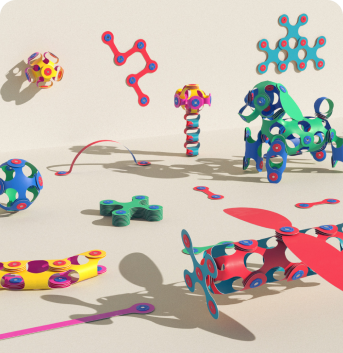The Birth of Clixo
While the idea behind Clixo has been developing in me over the course of my career, it officially began to take form in 2017, as I watched design students get incredibly creative using only paper. The concept struck me: how could I use paper–an incredibly dynamic material–in a way where it would attach to itself?
I began to iterate as quickly as possible, using paper, hot glue, and magnets to test out different ways I could build shapes. My years of experience teaching, playing, and studying the philosophy and psychology of play was all coalescing into this project. I wanted to know how I could build something that could be more than one thing, and would encourage the greatest amount of free form, free range creativity.
At first, the iterations kept leading me towards a tube shape. This was interesting, but ultimately limiting. Sure, I could build a dragon neck or buildings or trees, but I felt that the system wasn’t flexible enough. I moved on to sets of geometric shapes: squares, triangles, and circles, but again, after hundreds of iterations, I ran up against a limitation. Geometric shapes wouldn’t transform in an intuitive, natural way from 2d to 3d. I wasn’t entirely sure why, but I knew that whatever I created needed to make this transformation gracefully, and geometric shapes wouldn’t offer that possibility.
It was at this point that I sat down with Oren Zuckerman, an expert in interactive technologies at miLab in Israel. After a long conversation, he said something I needed to hear. “Who cares about another dragon?” he said. “Go back to the fundamentals. What is your Lego brick?”
I knew there was something in the seed of my idea, but that I needed to begin again, stripping everything back to basics. I began playing with strips, and then strips that had circular ends. One day, I connected two strips with magnets at their center and saw just how dynamic this shape was, able to fold and click intuitively into endless different shapes.
If I had to point to a singular moment in which the base form for Clixo was created, this would be it. But the creative process is never about a singular moment or a strict before or after. All of my years of experience and playful exploration through iteration informed this moment, and the design just kept evolving from there. I discovered that the rounded nature of the shapes gave creations an organic feel, and that the base form very intuitively moved from 2d to 3d. The more I played with it, the more I surprised myself, constantly finding new ways to attach the shapes and transfigure them.
As a creator, I never want to discover the full potential of anything I create. My ultimate goal is to aid and nourish the infinite possibilities that children are able to come up with through approaching a toy in unique and varying ways. My job is to facilitate, not control.
In fact, Clixo isn’t so much a static toy as a family of shapes that work together as a tool for creativity. We are constantly evolving and expanding the vocabulary of shapes, sizes, and accessories, not just based on our own ideas and discoveries, but based on yours. We always love to hear from kids (and kids at heart) about how we can expand the creative universe even further. What would you love to be added to the Clixo shape vocabulary?
We look forward to hearing from you at [email protected].
With love from the Clixo family,
Assaf
